#hermit crab care for beginners
Text
#animals#hermit crabs#crustacean nation#hermit crab#my pets#pet blog#exotic pets#pet blogging#pettmblr#hermit crab care for beginners#hermit crab shell#marine hermit crabs#hermitcrabcare#hermit crab supplies#hermit crab facts#land hermit crabs#hermit crab tank#hermitcrabs#hermit crab tank refresh#hermit crabs vacation#hermit crabs of instagram#hermit crabs rule#exotic
7 notes
·
View notes
Text
@officialpetco
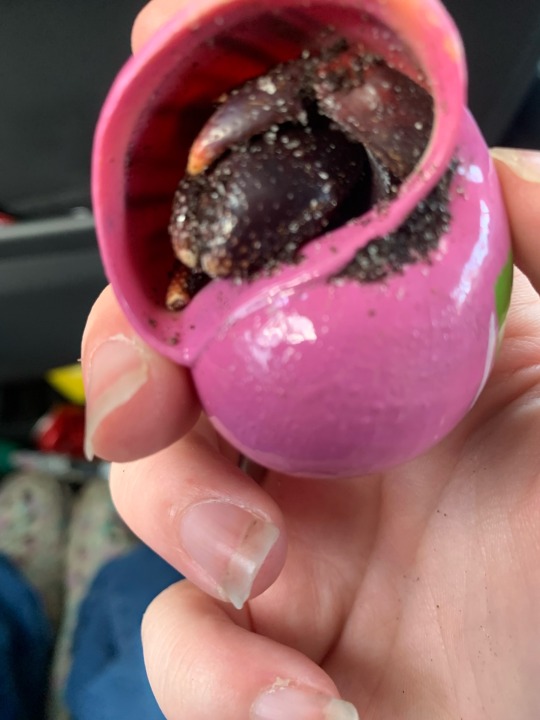
Loki had a pink, green, red, and yellow shell, he was deep purple (almost black) and he was very shy. He died from the poor treatment of hermit crabs in the pet industry and the incorrect treatment of animals that is and has been going on at Petco since its conception. Petco continues to give fake pamphlets and sell crabs in painted shell’s despite being well aware of the risk. Petco continues to ignore the people who actually care for these animals in the name of profit. It’s disgusting and revolting to habitually abuse animals in the name of your bottom line. These animals can live upwards of 30 years in both the wild and in captivity! And yet your posters say “10 year life span”. You sell products that are known to kill hermit crabs, such as pellet food, painted shells, painted cholla wood, sea sponges, tanks with unsealed lids, calcium sand instead of regular play sand, inadequate heaters and water dishes, not to mention the “you can have just one crab in a one gallon tank” shit when each crab needs 10 gallons. They need 5-10 inches of 1:5 cocofiber to play sand to molt. They need a humidity of 80% to breathe. They need both saltwater and freshwater. They need 50% protein 50% vegetables. Fresh food is ALWAYS better. They require the same level of care and expertise as most reptiles, and I certainly wouldn’t call them beginner pets. They need 3-5 shells per crab at all times to prevent shell jacking and them ripping each other to shreds. Petsmart isn’t much better. While they had a great temporary set up, the crabs I received were in shells much to small for them, to the point where Sunny left bits of his skin in the shell after switching to a much roomier turbo shell I provided for him, because every shell in their enclosed was the wrong type of shell for purple pinchers, who prefer turbo shells, instead of conical, or triangular shells. I wish both companies would stop the sale of hermit crabs and discourage beach shops from selling them as well. These animals are not disposable. They are not pets. They are wild animals stolen from their habitat and put through hell by people who couldn’t give a shit about their existence and values the more abused crabs at $13 and the less abused crabs at $6. Is that what a life is worth to you? These crabs don’t deserve the pain and suffering they’ve endured for decades at the hands of selfish tourist traps and greedy corporations who abuse animals for profit.
3 notes
·
View notes
Note
Has anyone asked you recently: what is your favorite species to interact with but which you will never keep, and why?
Mine is the hermit crab. They are awesome little dudes if you can find an aquarium with an interactive exhibit but their parameters are so narrow and poorly understood that i’d put their lifespan in days to weeks with a beginner keeper. Plus they’re hard to breed in captivity, so most are wildcaught.
Alternatively: any REALLY BIG snakes. I have a housemate with sensible boundaries around conscription to the position of “snake spotter.” (Leliana would be borderline too big for our household.)
Prairie rattlesnakes! (Odd answer, I know)
I am the snake removal person of my little town, and I've moved 2 of these guys. They are so calm, and their chubby faces are so cute! But, of course, they are venomous. Too dangerous for me to keep around, I am much to clumsy for that and were an escape to happen Pharoh would be in danger. I love the squish faces from afar :)
You're right about hermit crabs! It's sad so many people think they actually only live a few weeks, and get them as a 'first pet' for their kids. I wish more research was done about their care.
And honestly that's fair! It's good on you for respecting your housemates limits too :)
23 notes
·
View notes
Note
How do you keep your hermit crabs alive? Mine always die in a few months
Research and money mostly🥴
I’ve been to maybe one pet store than provided their crabs adequate (but still lacking) care and even then they sold supplies toxic to crabs, so you really have to do your own research if you want to provide your crabs good condition (crab central station on yt is a good place to start!)
Plus, hermit crabs aren’t the “beginners” pets they’re advertised to be. They require very specific conditions in terms of substrate, fresh and salt water, humidity, temperature, etc. so they’re environments are generally an expensive set up.
They’re fun and having healthy, happy crabs is super rewarding, but you really have to do your homework first. GL!

2 notes
·
View notes
Note
hello my friend. do you happen to know anything about hermit crabs? i'm waiting at least 6 months before considering buying pet hermit crabs of my own, to ensure that it isn't just a passing fixation and that i really do want them and am prepared to properly care for them. however, i would like to learn as much as possible about them in the meantime. i am also wondering, i assume that, much like reptiles in pet stores, most chain pet stores do not properly care for the hermit crabs they may sell? are there proper hermit crab breeders? where would one aquire happy, healthy hermit crabs bred for the highest possible quality of life? i also assume much information online about these animals is not correct, as i imagine many people are misinformed about them, or don't have their proper care in mind, seeing them as beginner pets or lesser creatures. essentially, do you or any of your followers have reliable information about these wonderful animals? thank you very much for your time. i am greatly enjoying crab chewsday, as crabs are vital to the ecosystem of my mental health.
oh boy! i sure am glad i remembered i had the "ship recs" tag because Oh Boy Ive Already Used It Twenty Times Today! dont worry though im not complaining its just funny!!! the timing worked out well! buuuuuuut yeah this gave me an idea for a funny poast but i cant actually answer any of your questiosn, so. dearest, dearest followers of mine. could you help this poor anon? :pleading_face:
140 notes
·
View notes
Text
Hey just a PSA:
There’s no such thing as a “beginner pet”. People always ask what’s a good “beginner pet” for their kids, and typically they don’t mean “what’s a good animal to start a nice fish tank with or get acquainted with reptile care” they mean “what’s a pet that my child can be interested in for a day and then never take care of again”. And that does not exist. All pets, even if they’re easy to care for, still require care.
Fish cannot be tossed in a bowl and never thought about again. Hermit crabs can’t be kept in a tiny critter keeper and expected to live a full life. That’s like keeping a dog in a crate it’s whole life and not understanding why it’s sick and unhappy. For the love of gods, take care of your pets.
131 notes
·
View notes
Photo
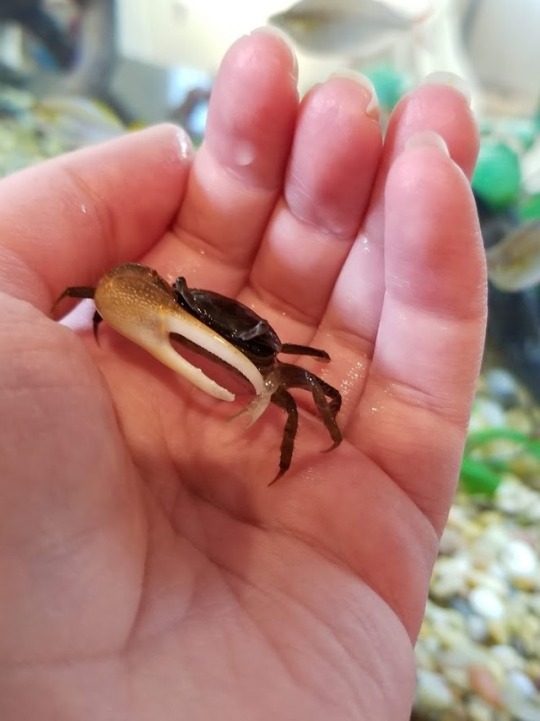

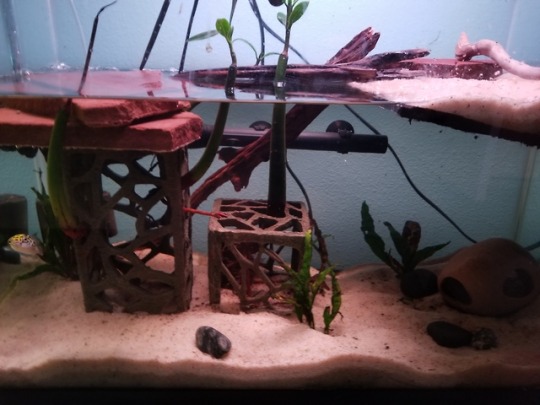
Why Not Brackish?
I’ve done fresh water guides on this blog and I’ve done salt water ones, but there is one tank type that I don’t think I’ve given any attention to yet. Brackish tanks are the half way point between fresh water and marine aquariums. They recreate estuary ecosystems, and damn can these be fun!
Brackish tanks just don’t get enough love in my mind. These are by far, some of the coolest ecosystems. You will find some really incredible animals in tanks like this. I’ll be honest, I don’t have a set up for brackish tank at the moment. I’ve had so many tanks, but this tank above was one of my all time favorites! It’s not gorgeous, but it served me well. I hope to get one going again soon.
If you haven’t encountered one of these tanks before, you will probably be wondering what kinds of animals inhabit these kinds of tanks. There are a lot of very unique options. Many dwarf puffers, flounders, crabs (fiddlers and hermit crabs), and gobys make their homes in these water perimeters, and fish like mollies and guppies THRIVE in them.

Now while guppies, mollies, and many invertebrates such as ghost shrimp and nerite snails, are beginner tank fillers and great to start with, there are a lot of animals in this category that require a little more knowledge and care. Above, you can see the figure 8 puffer on the left and a flounder in the middle. Both of these fish are good examples of this.
The figure 8 is a very intelligent animal, like most puffer fish, and because of this they require a lot of stimuli to keep healthy. They need a good amount of space to explore, an adequate current (not too strong, but enough to provide some exercise), a varied diet, and a lot of times even toys! My green spotted puffer had a plastic cat toy he liked to toss around, and always wanted to play with my magnetic, glass cleaner. They are very aggressive most times, so you should plan your tank out accordingly.
As for flounders, I have never had one personalty, but I have cared for many. Let me tell you, they are picky. Especially when it comes to food! These are ambush predators. As such, they strike at moving food. Many will need to start with small live shrimp, or blood worms and be slowly transitioned to more easily provided foods.
The last image shows a bumblebee goby. One of my favorites! Many fish in the goby family are a good middle ground for fish keepers. They are still a little bit picky, but are much more willing to accept frozen foods, and easier to transition between foods. They can be a little aggressive and should not be trusted with any animals that will fit in their mouth. They WILL eat them.

Invertebrates for these tanks also come in a few in a few difficulty levels. On the right, you’ll see a brackish hermit crab. Note that there are MANY different kinds of hermits!! make sure you get the right kind! These little guys are a lot of fun, but surprisingly enough they are one of the more difficult inverts to keep. They fit in a pretty good group with fiddler crabs, since they require many of the same things. The biggest challenge comes in with both of these crustaceans needing dry land to come out onto. You’ll notice in my home made, beach tank that there is an elevated platform with driftwood that allowed my fiddler crabs to climb up onto it. They will also require fresh water for drinking, and often time either fresh or dried fruits and veggies. Its a lot to consider when setting up a tank.
Nerite snails, on the left, are one of the easiest. In my opinion a must have as one of the only brackish snails to help you clean your tanks glass. Ghost shrimp are an excellent cleaner as well, just keep in mind that they are easy chow for hungry puffers and goby!
The last thing to consider with these tanks is that it is a very real challenge to grow plants in these settings. I have only personally had success with java fern and mangroves. If you want a lush, green tank this may not be the direction you’ll want to go.
So now you’ve been properly introduced to these lovely tanks. Maybe this will be your next tank set up! Or maybe you’ve ruled it out completely. Either way, I hope you found my spiel interesting, and you leave this page having learned something new!
22 notes
·
View notes
Note
you've made me want to get hermit crabs lol do you have a beginner care sheet you recommend?
Heh, glad to show people how interesting they really can be! I have a couple posts that go over the basics here:
https://fantasticbeastsandhowtokeepthem.tumblr.com/post/163504637029/do-you-have-a-post-or-a-list-of-things-you-need-to
https://fantasticbeastsandhowtokeepthem.tumblr.com/post/182571552514/hello-ive-seen-your-wonderful-crab-posts-and
I also used this forum a lot when I was first researching and starting out with my crabs - http://www.hermitcrabassociation.com/phpBB/viewforum.php?f=120&sid=c918d318205f404d2d6ebc4709eec190
I don’t agree with their space recommendations, but that’s my main issue with them. For Facebook groups, I’m mostly active in the Land Hermit Crab Owners Society group, which is the counterpart to http://crabstreetjournal.org/
I also have a post that talks about where you can buy food for them - https://fantasticbeastsandhowtokeepthem.tumblr.com/post/163525780954/hermit-crab-food-shopping
One on nutrition - https://fantasticbeastsandhowtokeepthem.tumblr.com/post/163525731439/hermit-crab-nutrition
And here’s a good post on shells - https://fantasticbeastsandhowtokeepthem.tumblr.com/post/135316962746/hermit-crab-shell-guide-on-shell-types-and-buying
And please, please consider adopting crabs instead of buying from a pet store! There are a lot in need of homes from people who got tired of them or could no longer keep them, and IMO, it’s a much better option than supporting the irresponsible ways hermit crabs are captured, transported, and treated by the pet industry. You can look for crabs for adoption from http://lhcos.org/adoption-program-beta/ or http://www.hermitcrabassociation.com/phpBB/viewforum.php?f=13
Or you can also keep an eye on Craigslist, especially with summer coming up. End of summer & beginning of fall is when you get a lot of people posting hermit crabs that were vacation purchases from beach stores.
And on the long shot that you’re anywhere close to me (Kansas City), I’m happy to adopt out most of my crabs (my two jumbo boys excluded) so that I can continue taking in Craigslist rescues. :)
20 notes
·
View notes
Text
Opae Ula Care
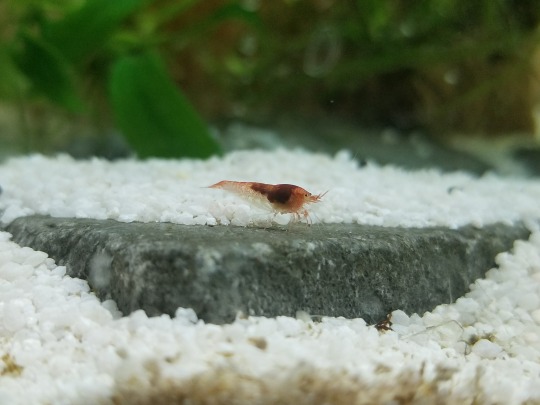
Introducing the tiny tank known as the Opae Ula or in scientific terms Halocaridina rubra. These shrimp are native to Hawaii typically found in anchialine pools, due to where they live they have evolved to survive harsh environments such as temperatures drops (30° f), low oxygen levels, no food for up to years, and extreme changes in salinity.
Sadly their hardy nature has allowed them to fall victim to Ecospheres or micro ecosystems which are enclosed (sometimes open) small spheres of stagnant water where these shrimp can be forced to endure many of the harsh environments addressed above for months to years.
Let's do these tiny shrimp some justice and give them a environment they can thrive in and not just survive in.
Scientific name: Halocaridina rubra
Common names: Red Hawaiian shrimp, opae ula, supershrimp, red shrimp, and volcano shrimp.
Care level: Beginner, due to their hardy nature these guys make a good introduction to shrimps and brackish tanks.
Water: These guys can live in freshwater, brackish, and even saltwater. However they truly thrive in brackish waters of 1.008-1.016 specific gravity or 11-21ppt.
Temperature: 75-85°F / 23-29°C.
Tank size: 5 gallons is the minimum for a group of these guys, but 10 gallons is heavily recommended as to make maintaining salinity and temperatures easier. When kept properly in these guys will easily breed so that’s something you’ll defiantly want to consider when choosing a tank size.
Size: 0.5" is the average size. Much smaller then most freshwater shrimp you'll see for sure!
Feeding: These guys are scavengers much like other species of shrimps and will eat a variety of foods such as pellets, algae wafers, veggies/leafy greens, etc. Currently I feed mine high quality pellets, algae wafers, spirulina and the occasional blanched zucchini and leafy greens.
Here are some articles that can give you a idea of what to feed, they are not made for opae ula most shrimp have the same tastes;
Planted Tank
Natural Pet care
Aquarium tidings
Filtration: Most care sheets are going to tell you to skip right past filtration and use the excuse “They prefer slow moving waters” or “It stresses them out” which is completely false. Well these guys can survive without a filter, they surely aren’t going to thrive in a tank without one. Like any tank they need a cycle of beneficial bacteria to help cycle out the bad stuff, but since they prefer slow moving waters you aren’t going to need anything very strong.
Personally I use a sponge filter in my tank, but I also have a weak power head to assist in preventing any dead spots in the tank and my shrimp don’t mind it.
When choosing a filter you’ll want to make sure your shrimp and baby shrimp aren’t going to get sucked into the intake so any filter then a sponge might need some modification.
*Cycling a brackish tank is very similar to cycling a freshwater tank, if your unfamiliar with cycling check this article out. Fishless cycle is preferred, but if your freeing yours from a ecosphere its better to do fish-in then leave then in the sphere.
Tank Mates: Since these shrimp are so tiny you aren’t going to be able to keep them with any fish since they’ll just become a snack to them. There are a few invert tank mates you can keep with your shrimp depending on the salinity you choose to keep yours in. Please research the specific invert and species you want before adding them to your tank, this is only a suggestion or to give you a idea of what you can stock!
Nerite Snails, these snails come in a variety of colors and sizes depending on the species you choose. Many thrive in brackish waters and can also live in freshwater, but keep in mind they also will breed in brackish water. 10g minimum.
Blue-legged Hermit crabs, tiny adorable hermit crabs commonly kept in saltwater tanks as a clean up crew can safely be kept with shrimp. They are mostly found in saltwater, but can also be found in high end brackish waters. 10g minimum.
Other snails, theres many other snails besides just the nerites that can be kept in brackish tanks like Malaysian trumpet snails(1.010), assassin snails(1.003), rabbit snails(1.003).
Other shrimp, if kept in freshwater or low brackish you can keep other species of shrimp like cherry shrimp(1.003) and amano shrimp(1.005).
Decor: These shrimp prefer lots of hiding spots and will be stressed if left out in the open. Using plants (in fresh or low brackish) is a attractive and easy way to provide your shrimp with cover. Here’s a good post on brackish tolerant plants!
Live rock is commonly used in saltwater tanks, but it can also be used in brackish tanks in a similar way. It provides lots of cover for your shrimp since it has lots of holes and crevasses for them to hide in. If you want to add a little green to your tank you can also use macro algae though! List of brackish tolerant macro algae here.
Water Changes: Many care sheets will tell you not to do water changes since it stresses them out, it is true it’ll stress them out, but it does not mean you should keep your shrimp in dirty water. A quick water change certainly isn’t going to kill them and a moment of stress for clean water is going to outweigh the downsides. Weekly or bi-weekly 25% water changes should be done on the tank. Personally I do mine bi-weekly since my tank is established and under stocked, I keep a eye on my water quality and do them before if needed.
Conclusion:
I hope this care sheet helped you guys out, if you have any questions or concerns feel free to shoot me a ask!
Also got a ecosphere and want to free your shrimp and give them a better life, but not sure how to crack that thing open safely? Check out this video! If you can’t watch the video I’ll give my best description:
On the bottom of the sphere there is a area where the sphere is sealed with a ring of silicone, carefully work around the silicone, and once you’ve worked that off pour the shrimp into a container.
*Also you are going to want to drip acclimate your shrimp to minimize stress and deaths.
Sources;
The Brackish Tank
Opae Ula UK (theres a lot to read here!)
Opae Ula Breeding (Opae Ula UK)
Opae Ula Care (Opae Ula UK)
Pet Shrimp
#opae ula#brackish#brackish tank#shrimpblr#shrimp#fishblr#aquablr#volcano shrimp#red shrimp#Hawaiian shrimp#red Hawaiian shrimp#how many stupid tags use I use before people get mad#ecosphere#fuck ecospheres#super shrimps#if you have a ecophere im going to break into your house break it and steal your shrimp#I had a ecosphere once and now I have over hundred shrimp and a 20g tank for them#tanks are prettier them hell orb
87 notes
·
View notes
Text
hermit crabs are Not a beginner pet holy shit i could talk about their care for days on end
3 notes
·
View notes
Text
Make an easy tire swing for hermit crabs!
#hermit crabs#animals#crustacean nation#hermit crab#hermit crab tips#hermit crab care guide 2023#hermit crab tip#hermit crab care for beginners#hermit crabs rule#hermit crab toys#my pets#happy pets#tiny pets#little pets#adorable pets#spoiled pets#small pets#exotic pets#pets#cute pets#pets of tumblr#petsofinstagram#petblr#cute animal videos#animal lover#small animals#cute animals#funny animals#baby animals#love animals
18 notes
·
View notes
Note
Hi! I’m really interested in having some hermit crabs of my own and was wondering if I could have some tips and pointers for a beginner so they can have a good life!! Your blog is amazing btw 😊
Hi! I’m really glad you’re doing research before you get your crabs. For general crab care information you can check my tags - hermit crab care is a bunch of random crab care information. This post in particular has links to how I’ve got my tank set up, substrate choices, and how I feed my crabs. For other specific topics you can try the tags hermit crab shells, hermit crab nutrition, or crabitat.
I’m glad you enjoy my blog - I hope it can be a good information source as well as having fun pictures. If there’s anything you can’t find information on, let me know and I’ll try to include it in a future post!
4 notes
·
View notes
Text
THE REAL BLUE LAGOON

Before Love Island there was The Island, and before reality shows broke our collective spirit forever, there was The Blue Lagoon.
Actually there were two Blue Lagoons. The latter film starred a barely legal Brooke Shields and a guy no one remembers, and the first starred Jean Simmonds and …a guy no one remembers.
Both films – and even the first Love Island when it had budget – were filmed in the Yasawas, the most beautiful island group in Fiji. Acres of white sand beaches, seven different blues in the water, impossibly cute hermit crabs, and the only threat to your wellbeing the occasional falling coconut.
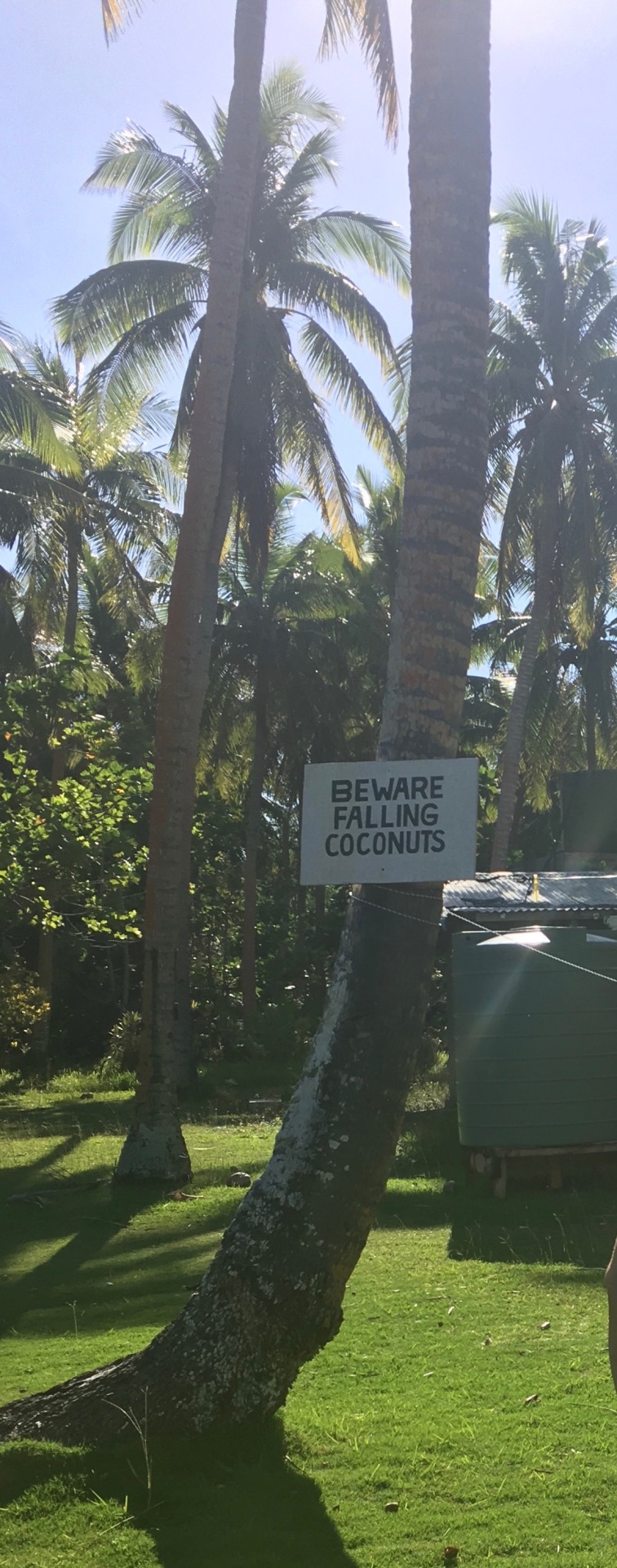
Never has so much been handed by so few on a plate to Hollywood. Oh, and there is an actual Lagoon called Blue. The snorkeling is jaw dropping, even for the inept beginner.
But for those who live there, it's all about the isolation and a simple life. Eat mainly what you grow. Raise your chickens in the back yard and set coconut traps to catch your crabs. And at night, you sit on the deck and listen to the cicadas, the wind rustling the coconut leaves, and yes, ok, the occasional out-of-tune karaoke strain of a pickled tourist.
My brother-in-law Darcy’s Auntie Joan lives on the far side of Tavewa, the most remote island of the group, which we visited this summer. Auntie Joan is a magician who daily conjures up nostalgic bakes, buns and biscuits in her Picture Post fifties kitchen. Must be something in the name, as my own Auntie Joan in Buenos Aires, now 95, was always the cook of the family.
Like her Argentine namesake, Darcy’s Auntie Joan doesn’t suffer fools gladly. And as my nephew and his friends discovered, you can stray into fool territory simply by scraping a coconut the wrong way. More of this later.

Auntie Joan's father built her house facing into the bush. She told me she hated the house when she first saw it because it looked away from the sea. It now it keeps the prying eyes of wandering tourists away from her and the family. In fact, the occasional drone of a seaplane and the bickering of her two dogs Rascal and Red (who guided us in the path along the beach and over the bush back to our bures at night) are the only sounds that disturb the quiet.
Until the family arrives.
My nephew had started building anticipation of Auntie Joan’s coconut buns (no sniggering in the back row) on the boat over to her beach. He was clearly a fan. So, naturally, and once I felt we had got to know each other after 24 hours, I asked her for the recipe. From the sideways glance I got by way of a reply, I wasn't sure that question had gone down well. Then she leant closer and said: “You learn by looking.” In other words, you want the recipe, you make the effort, baby. Fair enough.

So I spent the following afternoon closely watching Auntie Joan’s process and taking feverish notes on my iphone while the rest of the family got stuck in to prepping the coconuts.

Coconut scraping is a rite of passage for teenagers in Fiji. And you need the right tool. In this case a flat plank of wood with a circular set of teeth at the front – a bit like Alien’s jawline. You stick the plank between your legs and move each coconut half in a circular movement around the teeth. And if you are not aroused by now then you can get up slowly, walk away bandy-legged and start extracting the liquid from the desiccated heap you have created. Impressively, and a tad surprisingly, my friend Sue (who was travelling with us) took to it like The Kardashians to hair extensions.
Then you have to squeeze the grated coconut to extract the milk. Don’t even think of reaching for a tin: “Well, if you must you must,” said Auntie with a flick of her wrist as she kneaded the dough. I mentally translated that flick as sign language for ‘you are dead to me’, while outside my nephew and his friends were torturing the milk out of the grated coconuts in a hessian and stick rack. It’s a process.
Auntie Joan wasn’t my sole food inspiration on Tavewa – Mellika, who ran the island’s grocery store, rustled up some mean Paw Paw scones for breakfast, and then kindly posed for this picture.

However, Auntie Joan’s coconut buns were the highlight. In their traditional boiled state they are no oil painting, but for the hungry snorkeler they were ambrosia. Yeasty, coconut-ey, and poached in yet more coconut milk, one is never enough.

You can also bake them in coconut milk if you want a golden crust to the bun and don’t want to compromise on eating with your eyes.
However, when I came to write this blog I decided that even as a breakfast bun, people back home faced with a pile of coconuts and the will to live, may find the preparation of these too much bother. So I have developed a dessert version– the Coconut Baba – which you can knock up over a couple of hours and leave alone more most of it. I also persuaded Mellika to give me her Paw Paw scone recipe, which I have adapted here for a family of four rather than 50 rabidly hungry tourists. And for something to eat before you drown in sugar, I have created a light octopus and fennel salad.
As Auntie Joan would say: “Pay attention, dear.”
Coconut Baba with Mango Lime compote

This is a version of the French Savarin dessert – an enriched yeast cake soaked in syrup. My coconut twist is to replace the traditional rum with Malibu, with some toasted coconut to sprinkle over the mango lime compote and thick cream that you will want to serve with it. You can also substitute the butter in this recipe with coconut oil, although the finish of the cake won’t be as silky smooth.
Serves 8-10
Ingredients
For the dough:
105g soft, unsalted butter or coconut oil (if using, melt over a low heat first)
10g fast action dried yeast
2 tbsps. (15g) honey
120g self-raising flour
120g plain flour
60g fresh white breadcrumbs
Pinch of sea salt
7 large eggs
For the syrup:
300ml Malibu or other coconut liqueur
300g caster sugar
300 ml water.
For the compote:
300g mangoes, chopped reasonably small
50g caster sugar
1 tbsp Malibu
Juice of 1 lime
Toasted coconut to serve
How to make.
Tip all the ingredients for the dough into a large bowl. Make sure that the yeast and salt are added before the wet ingredients and that they don’t touch each other (otherwise the salt will kill the yeast). Mix for 6-8 minutes using a dough hook, until the texture is a loose batter and the gluten is stretched. Cover with cling film and leave in a warm place for about an hour, until doubled in size.
Heat the oven to 170C/ 150C fan and butter a Bundt tin. Pour the mixture into the tin, taking care to distribute it evenly and not spill any, and leave for another 30 minutes to rise again.

Bake for 30 minutes, or until it is lightly golden and a skewer inserted into the middle comes out clean. Turn it our onto a wire rack to cool.
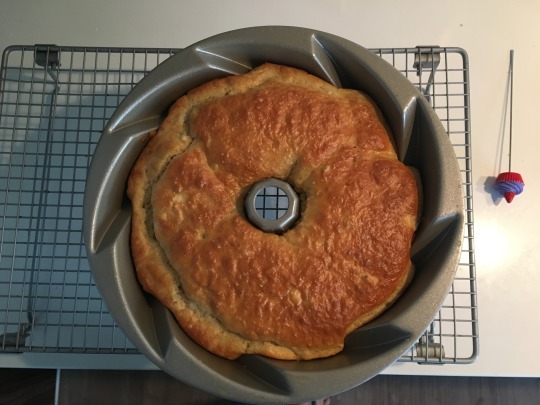
Make the syrup, bring the sugar, water and Malibu to the boil in a saucepan and then boil for five minutes. When the cake is cool, return it to the tin (i.e. bottom up), drizzle the warm syrup over it, leaving it to soak for 20 minutes. Turn the baba back out onto a plate.

For the compote: put the mangoes, sugar and Malibu in a saucepan and stir on a medium heat for 3-5 minutes. Squeeze in the lime juice and leave to cool. Dry fry two handfuls of desiccated coconut in a small frying pan until brown, but take care not to burn.
Serve slices of Baba, with a spoonful of compote and a generous dollop of thickened double cream, and sprinkle with the toasted coconut.

Papaya (Paw Paw) Scones

This makes a deliciously light and fragrant scone. It could work well with mango, but there is something about the creaminess of the paw paw which makes it perfect for this.
Makes 12-16 scones.
Ingredients
2 papayas
Juice of ½ a lemon
40ml tinned or frozen coconut milk (sorry Auntie)
¼ cup sugar
¼ tsp. vanilla
2.5 cups plain flour
125g salted butter, softened
How to Make
Heat the oven to 200C
Peel and de-seed the papayas and blend them to a pulp in a food processor. Rub the butter into the flour until crumbly, then add the rest of the ingredients and mix to a sticky dough. This will be stickier than your average scone dough, so don’t over mix it.

Grease the brownie tin and line with greaseproof paper. Spoon the mixture into the tin and bake for 12-15 minutes. Cool slightly, then take a cookie cutter and cut round scones from the tray bake. Pop these scones onto a wire rack to cool slightly.
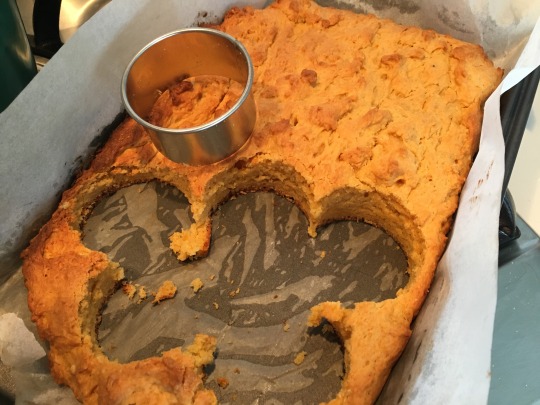
Serve warm with butter or clotted cream and apricot jam.
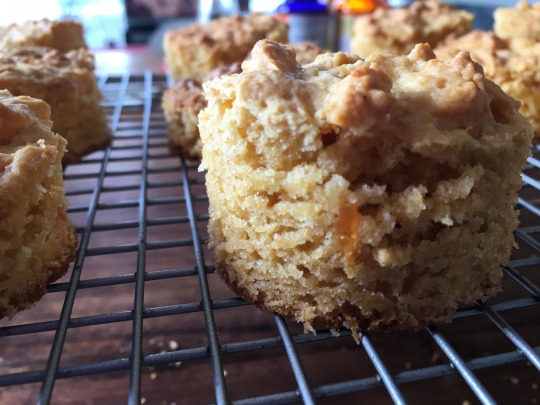
Octopus and Fennel Salad
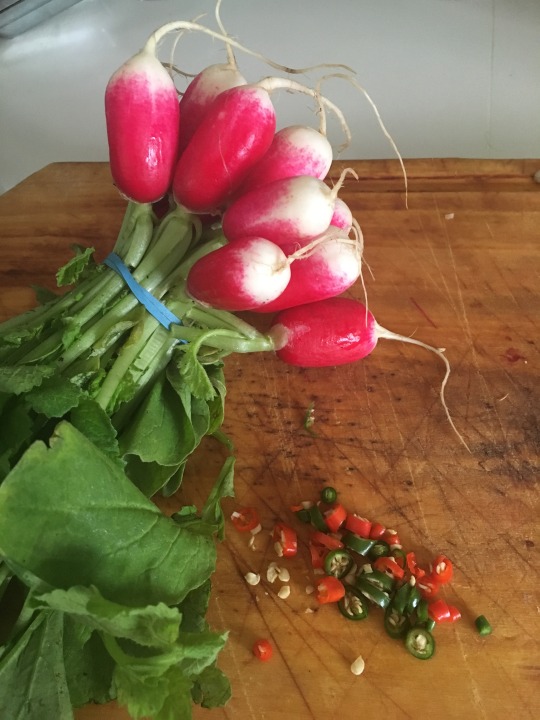
This can be as quick as 10 minutes to pull together, as long as you can get hold of ready-cooked octopus. Luckily, in London at least, you can now buy cooked and prepped octopus tentacles at Wholefood Market. But if you cant get hold of this, then substitute squid: clean it and cut it in strips, score the flesh and flash fry it in a little olive oil for 30 seconds – 1 minute.
Serves 2-3
Ingredients:
2 cooked octopus tentacles cut into 1 cm pieces
5 radishes, sliced finely
½ a head of fennel, sliced finely
4 spring onions, sliced
Few sprigs Flat leaf parsley
1 red and 1 green bird’s eye chilli
Juice of 1 lemon
3 generous glugs extra virgin olive oil
Sea salt and freshly ground black pepper

How to make
Mix all the chopped vegetables with the octopus, and arrange on a platter.
Whisk up a simple vinaigrette with the lemon juice, olive oil and seasoning, and pour over the salad. Add an extra turn of the black pepper mill and serve.
1 note
·
View note
Text
~pets for college students~
Hi! My name is liberty and I work at a small pet store. I am a member of petblr and studyblr, so I decided to make a post combining them!
Since I live in a college town, a lot of students come to my store looking for pets for their dorm. A lot of times they’re pretty uneducated about pet care, or are choosing the wrong type of pet for themselves. I’m going to give some information about basic pets that are imo suitable for college students, and the pros and cons of them. *high school students can use this too!*
First of all, check with your college/apartment to see if they have restrictions on pets. Many colleges allow a 5 or 10 gallon tank. Many apartments have a limit on the size of fish tanks/animal species.
Second, how busy are you? Many college students are very busy with classes and ECs and hanging out with friends, so you probably won’t want a very needy pet.
Fish- specifically betta fish
Betta fish, or betta splendens, are also known as Siamese Fighting Fish. They come in a ton of different colors and have different fin shapes. They’re very beautiful! They are also relatively low maintenance. However...many people are uninformed about their care.
Bettas require at minimum, a 5 gallon tank. This is perfect for students living in a dorm! You can find fish tanks for cheap on craigslist, or during Petco’s dollar per gallon sale.
Bettas need water that is heated to between 78-80 degrees F, because they are tropical fish. They also need a filter and a tank that has been cycled.(for more info on the cycling process, see this post.)
Bettas are solitary fish, but can do will with shrimp or snails. *Do not ever put 2 male bettas together! They will fight to the death!*
Bettas have great personalities and love live plants. They usually live 3-5 years.
Other species of fish tend to need larger tanks, most at least 20 gallons to live a healthy life. All fish species have different needs, so do your research before going to the pet store!
Small Mammals:
Hamsters and mice can make great pets for a college student, if you have to space. Do not ever buy the plastic enclosures that pet stores recommend! Animals can chew through the plastic which is bad for them and can cause health issues. They are also much too small and don’t have good air circulation.
Instead, at minimum, buy a 10 gallon(for 3-5 mice) or a 20 gallon long for hamsters. (However the larger the better!)
I do not reccomend guinea pigs, ferrets, rats, or rabbits to college students. These animals all need very large enclosures and a lot of social interaction and mental stimulation. They all can become very stressed and suffer from health issues if they do not have enough mental stimulation. They also tend to be very social and require at least 2 animals of the same species for them both to be happy.
For more information on caring for small animals, visit @claricespieces
Reptiles
If you are in a college dorm, you most likely cannot have any reptiles as pets. The vast majority require tanks at least 20 gallons and have heat requirements that many colleges view as a fire hazard.
However if you are able to and would like a reptile, I recommend a leopard gecko, a crested gecko, or a corn snake.
All 3 of these require at least 20 gallon tanks and have different lighting, heat, and humidity requirements. They all prefer to have various levels to climb.
Reptiles tend to have a pretty expensive startup price, as they require lighting, heating, and humidity. For example, a good reliable humidifier can go for 100$ or more. Heat lamps can also be expensive. However, they are very beautiful pets.
Most reptiles also get stressed from too much handling, so keep that in mind.
Many people also recommend ball pythons as beginner snakes. I’m on the fence about that- they are relatively easy to care for, but are extremely fickle and can go off feed for months at a time. They can also live 30 years and get around 3-6 feet long. However, my first reptile was a ball and i’ve had him for 5 years, and he’s doing great.
I don’t recommend chameleons(very complicated to care for, do not like being handled), large snakes, iguanas, or bearded dragons, as those species all get very large.
For more info on reptiles, check out @scalestails
Other animals:
Hermit crabs- have heating and humidity requirements, just like reptiles, need tanks. Do not keep in critter keepers.
Birds- Need large enclosures and lots of mental stimulation
Cats- Can do well if you have an apartment.
Dogs- be honest with yourself, especially if you want a puppy. Most college students are too busy for a puppy, and many for a dog. Check out r/dogs , they have a form you can fill out and people will reccomend breeds that may fit with your lifestyle. Or check out #dogblr.
Basically, the TLDR is to do your research. I do not like when people walk into the store and have done no research on the pet they want, and most of the times I will refuse the sale. Be honest with yourself about your activity level as well, I can’t wait to get rats, but right now I don’t have the space or time for them.
This can also apply to high school students- many of the animals on this list live several years. For ex, if you buy a snake and then find out you aren’t allowed to have them in your dorm, who will take care of it? College can seem far away, but it will go by faster than you think!
Thank you so much for reading this! I hope you learned something, and if you see someone with a pet in a bad enclosure, please try to educate them! Our pets deserve the best care they can get!
#studyblr#Studyspo#fishblr#bettablr#hamblr#birdblr#reptiblr#snakeblr#petblr#dogblr#studying#college#collegeblr#pet care#pets
2 notes
·
View notes
Text
Sonic Heroes (almost nonexistent) plot is funny because it just rips on the characters fucking basic personality traits. If you don’t know, Metal Sonic is leading all the characters to him so he can fuckin hack into their DNA or whatever he does, so he does the simplest fucking shit to get them to come.
Team Sonic: Sonic, Tails, and Knuckles like to beat the shit out of Eggman because they (more so Sonic) think it’s fun, so guess what happens. Metal writes a letter to Sonic via an Eggman-themed postcard saying “Haha I’m gonna take over the world come kick my ass at this location.” Nobody questions it, and Tails is legitimately worried about it. Go save the world or whatever ya idiots.
Team Dark: Rouge likes jewels and treasure, there’s this robot who always fucking hates Eggman’s guts along with his other robots, and Shadow is here for whatever the fuck reason. So tell Rouge that there’s treasure in this room with the robot and Shadow so they can come and steal from and kill Eggman. Ironically enough, Shadow is the only one Metal Sonic needs and yet he is the only one who doesn’t care.
Team Rose: Amy wants to fuck Sonic, Cream is missing one of her dumb Chao that probably couldn’t even win a beginners footrace, and Big lost his fucking frog like always. So you make a fake newspaper article with Sonic stealing Chocola the Chao and Froggy the frog, so now they all have a reason to follow the people going to Eggman.
Team Chaotix: Remember Knuckles Chaotix? No? Well you were supposed to buy a tumorous growth for your Genesis along with the game, but guess what. You didn’t. Now they’re broke and they need to pay the rent so they go around collecting hermit crabs and putting out candles for some cash. And some of the shit they do happens to involve kicking fake Eggman’s ass.
They don’t even get paid in the end.
8 notes
·
View notes
Note
hey! i was wondering if you knew of a website or something that has a collection of good care guides? i work at a pet store and i only know the info from the care guides we have at the store. i was hoping to get some good, basic knowledge of beginner species such as leopard geckos, corn snakes, created geckos, etc. thanks!
Hey, sorry for the delayed reply! So usually good info on species is going to be on a species-specific site or from someone who’s got a lot of experience with that species (and maybe a few others). In general, you may have to do some searching to learn about the species you want to learn more on. The biggest thing is to check with multiple sites, especially if you’re not sure which sources are best.
That said, a friend who also works at a pet store did set this up for resources, so it should help you get started - https://petcarehub.weebly.com/ It may have some of the same things I link below here!
I know for ball pythons, my go-to is @wheremyscalesslither and her list of snake resources she’s written for BPs. For them especially, I would avoid most forums & such - the “bare minimum” keeping style is especially common with BPs.
Leopard geckos, I know @followthebluebell is good and I used to have a caresheet by @lizardbeans but the link doesn’t work anymore. And @fractiousrvt has corn snakes.
For some other common pet store animals…
Guinea pigs - http://www.guinealynx.info/
Hamsters - http://hamsterhideout.com/forum/ and http://how-to-care-for-hamsters.tumblr.com/faq
Mice & rats - http://www.petmousefanciers.com/ and http://www.fancyratsforum.co.uk/ and my bf is in FB groups “Rats and mice are awesome” and “the rat fan club”
Hermit crabs - http://www.hermitcrabassociation.com/ and http://crabstreetjournal.org and the FB group “Land hermit crab owners society”
Budgies & other small parrots, @flock-talk has tons of resources
I don’t really do fish at all other than betta fish, but there’s sources for fish on the site I first linked!
I hope this helps get you started a bit! Let me know if you have trouble finding info on anything else and if I can’t help, hopefully someone else on here can. :)
42 notes
·
View notes